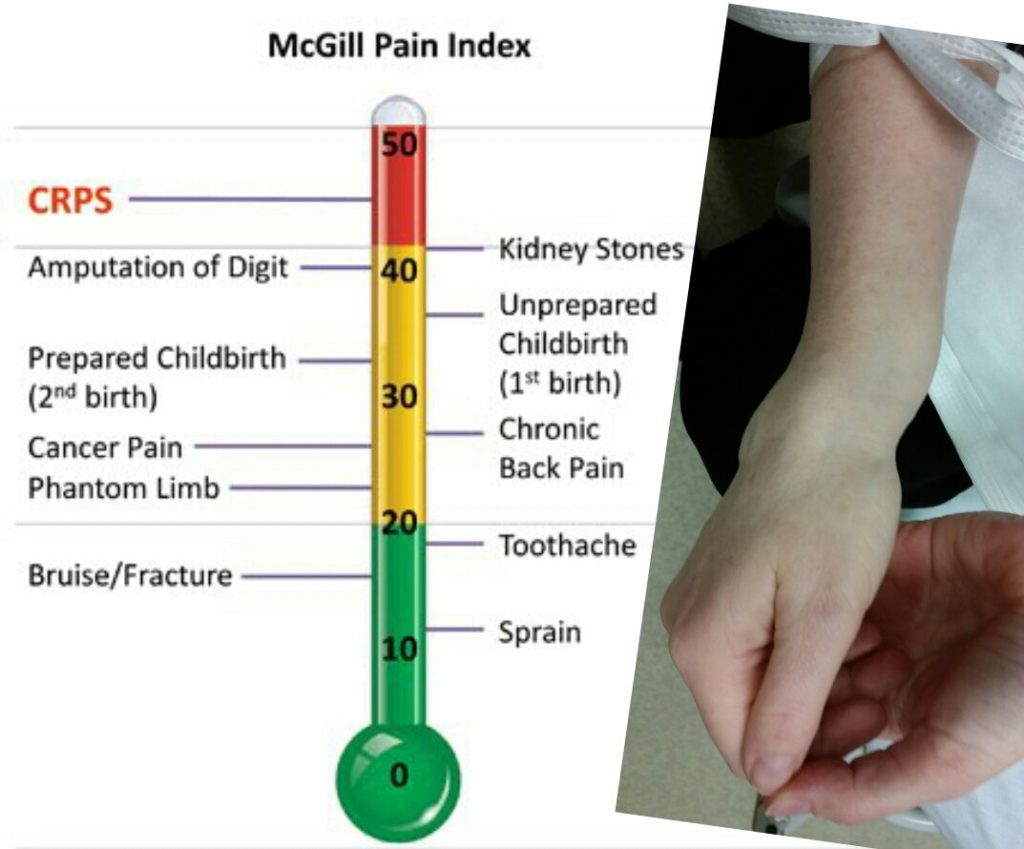Today’s the day I’ve been waiting for, since August! I have a rare disease called Complex Regional Pain Syndrome (CRPS), sometimes still referred to by its old name; Reflex Sympathetic Dystrophy (RSD). CRPS can cause a wide range of symptoms, making it difficult to treat.
This disease is also known to present differently in each patient(1), which means that any two people with this disease may have different sets of symptoms. The most common symptom, though, is severe pain. Constant, chronic, pain.
For the first few months after my diagnosis, my local community hospital was providing medical care for CRPS. Then, on August 19th, they unexpectedly stopped treating me; you can read about that experience here. They finally did, however, give me a referral to a much larger hospital.
The referral was to a Pain Management Unit, or PMU, at a large university hospital centre. Unfortunately, simply having a referral is not a guarantee that they’ll treat me. This PMU has a long waiting list, and doesn’t accept every patient who’s referred to them by other physicians.
So I’m really – really! – hoping that they’ll accept me as a patient. Today I’ll be visiting the PMU, at the Montreal General Hospital (MGH), for what I’ve been told will be a potential patient orientation session. It will be a group presentation, in which they’ll explain how the PMU works. This is so that patients will know what to expect, and to get an idea of what the wait time might be before they find out whether their case has been accepted.
The person who called me from PMU, to schedule this orientation, was clear that I won’t be meeting with a physician or nurse today. It’s more of an information session, for about 25 of the patients who’ve recently been referred to the PMU.
But I’ve been told that their wait time can be up to 12 months – a year – for some patients. And, because CRPS is an invisible illness, it doesn’t look as though there’s anything wrong with me. So my biggest fear, right now, is that they simply won’t accept me as a patient. I’ve been trying to hang on, kind of living on Advil and hope, for the past few months – while in excruciating pain.
Pain so bad, in fact, that it’s rated on the McGill Pain Questionnaire (MPQ) as worse than childbirth, kidney stones, and even the amputation of a finger or toe – without anaesthetic!

This pain scale, or index, was developed and validated back in the 1970s; at McGill University.(2) I use this index, with a photo of the fracture that triggered my CRPS, to give people an idea of what the disease feels like = Pain about 3 times as bad as pain from that broken arm!
So it seems fitting that the PMU to which I’ve been referred is part of the university at which this pain scale was developed. McGill University, in Montreal, operates a large multi-hospital health centre; the MUHC (called the CUSM in French). The MUHC includes seven different hospitals and institutes.
There’s also a high level of research in medicine and the health sciences, throughout the University and the MUHC. These are teaching hospitals, with a large number of students and trainees. I’ve been told that the MUHC accepts about 200 new medical students each year, on top of the over 1,000 medical residents and more than 2,500 others working in medical research.
But there’s more! The MUHC is world-class hospital centre, so they run clinical (medical) fellowship programs; doctors can come from all over the world to learn specialized skills at these teaching centres. A fellows is already a physician, someone who has chosen to spend an extra year or two in supervised learning – while also treating patients at the MUHC.
And then there are students from other areas of healthcare, including nursing, occupational therapy, physical therapy, psychology, psychiatry… And McGill also does a significant amount of other types of health research; bioethics (my field), health law, health policy, etc.
Why am I writing about all these other specialties at the MUHC? Because the PMU’s approach to pain management seems to be multi-disciplinary; not only physicians, but also physiotherapists, psychologists, and other healthcare professionals. They also have a pain research program, in collaboration with the PMU.
As you can tell, I’ve done some reading up on the PMU! I wanted to be as prepared as possible for the potential patient orientation session today. So wish me luck, today… that the PMU will accept me as a new patient. And soon! Thanks ‘-)
References:
(1) Goebel A. Current Concepts in Adult CRPS. Rev Pain. 2011 Jun; 5(2): 3–11. Online. doi:10.1177/204946371100500202. Accessed 25 Oct 2016.
https://www.ncbi.nlm.nih.gov/pmc/articles/PMC4590068/
(2) Melzack R. The McGill Pain Questionnaire: major properties and scoring methods. Pain. 1975 Sep;1(3):277-99. Accessed 25 Oct 2016.
https://insights.ovid.com/article/00006396-197509000-00006

